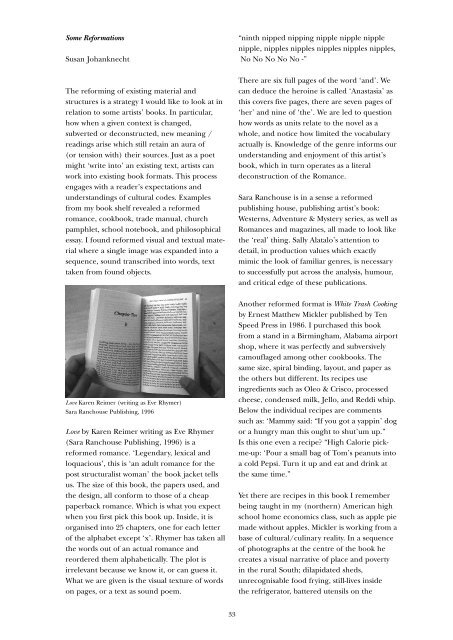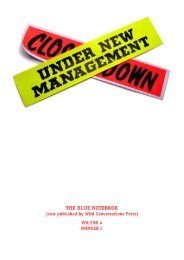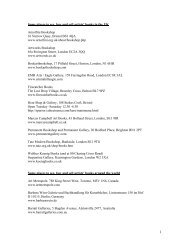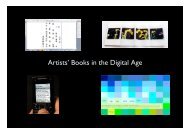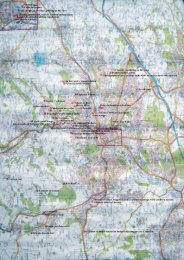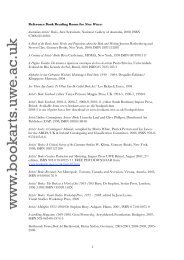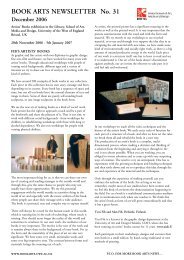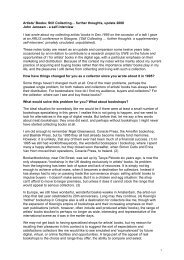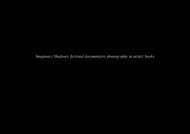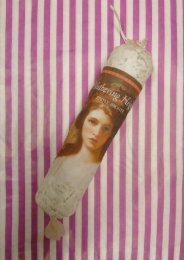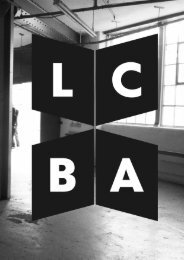Artist's Book Yearbook 2003-2005 - Book Arts - University of the ...
Artist's Book Yearbook 2003-2005 - Book Arts - University of the ...
Artist's Book Yearbook 2003-2005 - Book Arts - University of the ...
Create successful ePaper yourself
Turn your PDF publications into a flip-book with our unique Google optimized e-Paper software.
Some Reformations<br />
Susan Johanknecht<br />
The reforming <strong>of</strong> existing material and<br />
structures is a strategy I would like to look at in<br />
relation to some artists’ books. In particular,<br />
how when a given context is changed,<br />
subverted or deconstructed, new meaning /<br />
readings arise which still retain an aura <strong>of</strong><br />
(or tension with) <strong>the</strong>ir sources. Just as a poet<br />
might ‘write into’ an existing text, artists can<br />
work into existing book formats. This process<br />
engages with a reader’s expectations and<br />
understandings <strong>of</strong> cultural codes. Examples<br />
from my book shelf revealed a reformed<br />
romance, cookbook, trade manual, church<br />
pamphlet, school notebook, and philosophical<br />
essay. I found reformed visual and textual material<br />
where a single image was expanded into a<br />
sequence, sound transcribed into words, text<br />
taken from found objects.<br />
Love Karen Reimer (writing as Eve Rhymer)<br />
Sara Ranchouse Publishing, 1996<br />
Love by Karen Reimer writing as Eve Rhymer<br />
(Sara Ranchouse Publishing, 1996) is a<br />
reformed romance. ‘Legendary, lexical and<br />
loquacious’, this is ‘an adult romance for <strong>the</strong><br />
post structuralist woman’ <strong>the</strong> book jacket tells<br />
us. The size <strong>of</strong> this book, <strong>the</strong> papers used, and<br />
<strong>the</strong> design, all conform to those <strong>of</strong> a cheap<br />
paperback romance. Which is what you expect<br />
when you first pick this book up. Inside, it is<br />
organised into 25 chapters, one for each letter<br />
<strong>of</strong> <strong>the</strong> alphabet except ‘x’. Rhymer has taken all<br />
<strong>the</strong> words out <strong>of</strong> an actual romance and<br />
reordered <strong>the</strong>m alphabetically. The plot is<br />
irrelevant because we know it, or can guess it.<br />
What we are given is <strong>the</strong> visual texture <strong>of</strong> words<br />
on pages, or a text as sound poem.<br />
33<br />
“ninth nipped nipping nipple nipple nipple<br />
nipple, nipples nipples nipples nipples nipples,<br />
No No No No No -”<br />
There are six full pages <strong>of</strong> <strong>the</strong> word ‘and’. We<br />
can deduce <strong>the</strong> heroine is called ‘Anastasia’ as<br />
this covers five pages, <strong>the</strong>re are seven pages <strong>of</strong><br />
‘her’ and nine <strong>of</strong> ‘<strong>the</strong>’. We are led to question<br />
how words as units relate to <strong>the</strong> novel as a<br />
whole, and notice how limited <strong>the</strong> vocabulary<br />
actually is. Knowledge <strong>of</strong> <strong>the</strong> genre informs our<br />
understanding and enjoyment <strong>of</strong> this artist’s<br />
book, which in turn operates as a literal<br />
deconstruction <strong>of</strong> <strong>the</strong> Romance.<br />
Sara Ranchouse is in a sense a reformed<br />
publishing house, publishing artist’s book:<br />
Westerns, Adventure & Mystery series, as well as<br />
Romances and magazines, all made to look like<br />
<strong>the</strong> ‘real’ thing. Sally Alatalo’s attention to<br />
detail, in production values which exactly<br />
mimic <strong>the</strong> look <strong>of</strong> familiar genres, is necessary<br />
to successfully put across <strong>the</strong> analysis, humour,<br />
and critical edge <strong>of</strong> <strong>the</strong>se publications.<br />
Ano<strong>the</strong>r reformed format is White Trash Cooking<br />
by Ernest Mat<strong>the</strong>w Mickler published by Ten<br />
Speed Press in 1986. I purchased this book<br />
from a stand in a Birmingham, Alabama airport<br />
shop, where it was perfectly and subversively<br />
camouflaged among o<strong>the</strong>r cookbooks. The<br />
same size, spiral binding, layout, and paper as<br />
<strong>the</strong> o<strong>the</strong>rs but different. Its recipes use<br />
ingredients such as Oleo & Crisco, processed<br />
cheese, condensed milk, Jello, and Reddi whip.<br />
Below <strong>the</strong> individual recipes are comments<br />
such as: ‘Mammy said: “If you got a yappin’ dog<br />
or a hungry man this ought to shut’um up.”<br />
Is this one even a recipe? “High Calorie pickme-up:<br />
‘Pour a small bag <strong>of</strong> Tom’s peanuts into<br />
a cold Pepsi. Turn it up and eat and drink at<br />
<strong>the</strong> same time.”<br />
Yet <strong>the</strong>re are recipes in this book I remember<br />
being taught in my (nor<strong>the</strong>rn) American high<br />
school home economics class, such as apple pie<br />
made without apples. Mickler is working from a<br />
base <strong>of</strong> cultural/culinary reality. In a sequence<br />
<strong>of</strong> photographs at <strong>the</strong> centre <strong>of</strong> <strong>the</strong> book he<br />
creates a visual narrative <strong>of</strong> place and poverty<br />
in <strong>the</strong> rural South; dilapidated sheds,<br />
unrecognisable food frying, still-lives inside<br />
<strong>the</strong> refrigerator, battered utensils on <strong>the</strong>


